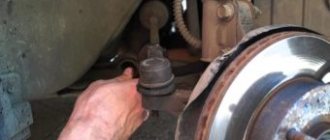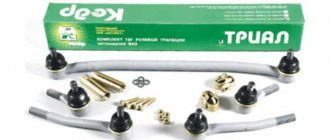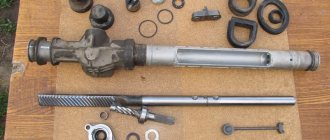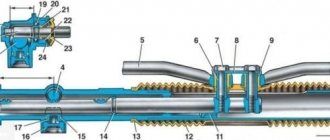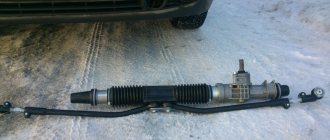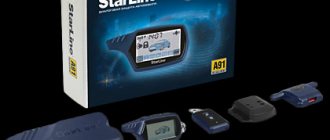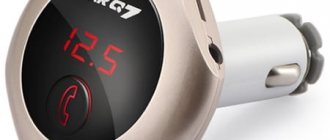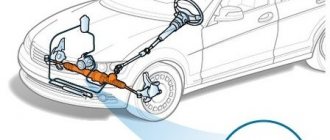The steering rack is a part of the car that enhances the effect of turning the steering wheel and transmits it to the control rods of the wheels. When the driver turns the steering wheel, the rack moves in a given direction and drives the tie rods, causing the wheels to turn. The steering rack is an important part of the steering mechanism of a car.
Thanks to its simple and reliable design, rack and pinion control is implemented in most modern cars. But when a car regularly drives on roads with poor-quality, uneven surfaces, its parts break down and wear out faster. A sure sign of failure or wear of the steering rack is an extraneous knocking sound while the car is moving. Worn racks not only make driving difficult, but can also lead to a serious accident.
Types of steering racks
There are three types of steering racks in modern cars:
- electrical;
- mechanical;
- hydraulic.
The mechanical steering rack has a simple device. At the end of the steering column there is a gear mechanism that is interconnected with a gear rack, which, in turn, communicates with the steering drive.
A hydraulic steering rack is implemented in most modern passenger cars. Power steering (power steering) increases the return on the effort exerted by the driver, and thereby ensures easy and comfortable driving.
The electric steering rack also improves the driver's response, but for this it uses an electric motor rather than a hydraulic booster.
The steering rack may be positioned differently in different car models. With the upper position of the rack, it is attached to the body and is located behind the engine; with the lower position, it is attached from below to the body, subframe or beam.
Causes of knocking in the steering rack
The main reasons for steering rack failure are driving on uneven roads and frequent hard braking. When the car moves over bumps and holes, accelerated wear occurs on the plastic support sleeve on the right or left side of the rack. As a result, play appears, which causes a knock in the steering column.
A knock may also occur due to weak tightening of the steering mechanism fasteners. In this case, it is not difficult to get rid of the knocking noise; you just need to tighten all the bolts and nuts on the connections.
The third reason for knocking in the steering rack is damage or abrasion of the protective rubber covers. Damage to the covers leads to the penetration of dust and dirt particles inside the mechanism, accelerating the wear of the rack and sliding support.
Corrosion is not a car’s best friend, as it wears away at the bushing and leads to a monotonous knocking sound. In case of corrosion, the knocking problem can only be solved by replacing the rusty part.
Finally, the bushing wears out due to the fact that it is made of insufficiently rigid material, which during off-road driving becomes deformed and ceases to perform its functions. In order for the part to last for a long time, it is better not to buy a new one in the store, but to machine a similar one from a more durable material, for example, caprolon.
Steering rack - everything you need to know about the mechanism
Did you notice that the steering rack began to knock and immediately despaired, deciding that it needed an expensive replacement? Don’t get upset ahead of time and listen to unprofessional mechanics who recommend completely replacing the entire assembly. First, it’s worth understanding its structure, which includes:
- A rack or gearbox designed to transmit forces from the steering wheel to the wheelset and directly perform turns.
- The steering rod to which the gearbox is attached.
- Tips that are attached to the wheels and are movable type hinges.
- It is worth emphasizing that in most cases, a knock heard in the steering column occurs when problems occur in the connecting elements, which does not require a complete replacement of the unit. The cause of such lesions is hard driving on uneven roads, as well as frequent sharp braking.
As the practice of mechanics shows, a malfunction of the power steering gearbox occurs due to:
- Poorly fastened fasteners - bolts and nuts, and in this case, to eliminate the knocking, simply tighten them.
- Wear or defects in the plastic bushing, which causes play during driving, accompanied by a specific beating.
- The bushing is coated with rust, causing play.
- Wear of protective rubber casings, due to which dust gets into the mechanism and causes defects in the internal parts.
Problems with the steering rack should never be ignored, as this may cause an accident. If alarming signs appear, it is recommended to conduct an independent inspection or send the car to a service center.
Fault diagnosis: how to do it yourself?
You can diagnose the problem yourself, or contact a car service center for help. Diagnostics will determine whether the unit can be repaired or will need to be replaced. Diagnostics are carried out in the inspection pit with the engine turned off. To diagnose yourself, you need to follow these steps:
- turn off the engine, put the car on the handbrake or put an assistant behind the wheel;
- climb down, closer to the place where the rail is located;
- ask an assistant to alternately turn the steering wheel right and left until it stops;
- try to determine where the knocking is coming from;
- inspect the steering rod joints for gaps;
- inspect the protective boots for damage and lubricant leaks;
- begin repairing detected faults.
If self-diagnosis does not allow you to identify the malfunction, you should contact a car service center for help.
Tie rod ends knocking
Either one tie rod end or both can knock. Let's try to diagnose this malfunction, understand its causes and solutions.
Using the example of steering tie rod ends for VAZ 2108, 2109, 21099 cars and their modifications.
Signs of malfunction: knocking tie rod ends
A failed tie rod end produces a small, repeating knock from the side of the wheel when the vehicle moves on an uneven road (crushed stone, ridges, holes, etc.). The knock is clearly audible and felt on the steering wheel. When driving on a flat road there is no knocking of the tips.
The knocking of the tips can be confused with the knocking of the anti-roll bar struts or the knocking of the steering rack. Therefore, for an accurate diagnosis, it is necessary to carry out a check.
Causes of tip knocking
The plastic liner located inside the tip body can be destroyed if dirt and moisture enters, or (the boot is torn) if the car is frequently used on bad roads, or the suspension is hit when driving through potholes and uneven surfaces. A similar effect will occur after installing a low-quality part, the service life of which may expire almost immediately.
When the liner is destroyed, the ball pin of the tip begins to “dangle” in its body, causing a loud knock. The greater the destruction of the liner, the more noticeable the knock.
Checking (diagnosis) of faulty steering tie rod ends
The easiest way to check the tie rod ends is to place the car on a level surface and grab the sides of the wheel with your hands. We pump the wheel away from ourselves and towards ourselves. If a certain amount of play is felt when the wheel rocks, the tip is faulty. You can check for play in the tip using a mounting tool as shown in the image below.
More complete and detailed methods for checking tie rod ends are described on the page: “Checking tie rod ends.”
Replacing faulty tie rod ends
Replacing a faulty tip can be done using a special device, or without it (using a hammer and a pry bar). Read more: “Replacing the tie rod end.”
disconnect the tie rod end using a pry bar and a hammer
Notes and additions
— The tie rod end of VAZ 2108, 2109, 21099 cars is a ball joint. The tip finger is made in the form of a sphere on one side and a threaded part on the other. The sphere is rolled into the tip body. The body has a plastic insert pressed against the sphere by a spring. The hinge is sealed with grease and covered with a boot on top. When the liner is destroyed, a play appears inside the hinge, which causes a knock when a load appears on the tip.
— The service life of tie rod ends on VAZ 2108, 2109, 21099 vehicles is up to 20 thousand kilometers (depending on the quality of the part and operating conditions).
— To maintain the tips in working condition for as long as possible, it is recommended that when installing new parts, additionally add a little lubricant to the boot and constantly check the condition of the boots.
More articles on malfunctions of the steering, suspension and chassis of the car
Malfunction - the ball joint is knocking Replacing tie rod ends Renault Logan Wheel bearing noise
The simplest DIY steering rack repair
After identifying a malfunction, the car owner can:
- try to fix the rack yourself;
- seek help from a specialist;
- carry out a complete replacement of the unit.
If the gearbox cannot be restored, you will have to install a new one instead. Buying a gearbox will cost the car owner a tidy sum, but a new part will last longer than a reconditioned one.
If the cause of the knocking in the steering rack is the tips, then the car owner will get off with a “slight fright” by paying a small amount to replace them at any car service center. Without the appropriate skills and tools, it is not recommended to repair the tips yourself.
If diagnostics have shown that the knocking comes from the junction of the rack and the rod, then this defect can be eliminated independently. To do this you need to do the following:
- remove the protective boot and remove the grease;
- if the bushing is damaged, replace it;
- clean the spring from dirt; if necessary, remove it and wash it with diesel fuel or a special liquid;
- if there is damage to the boot, including microscopic tears and cracks, then it should be replaced;
- tighten the bolt that regulates the movement of the sleeve, being careful not to overdo it and damage the entire mechanism.
Finally, it is necessary to reassemble the steering components and once again check how it works. If you did everything correctly, the knocking noise in the steering rack will disappear. If repairs do not help solve the problem, it is better to seek help from a specialist.
If a power unit with a hydraulic booster is installed on the car, then before dismantling it, the high-pressure pipes should be released and the working fluid should be drained into a clean container. Before removing the power steering gearbox, you should remove the car subframe. It will not be possible to do this without outside help. Therefore, it is better to invite an assistant in advance, or take the car to a car service center.
IMPORTANT! To repair the steering rack yourself, it is better to use a special kit, which includes new oil seals, seals and a bushing. Such kits are sold at car markets and auto shops.
How to eliminate a knock in the steering rack
Knocking in the steering rack can only be eliminated in one way - by carrying out repair or maintenance work. Further steps will be relevant only after complete and accurate identification of the source of the knock, otherwise the work will be in vain.
So, the most vulnerable areas of the steering wheel are: bearing, block, bushing, boot, rack gear mechanism. When carrying out visual diagnostics, many defects, prerequisites, and breakdowns may not be visible due to their secrecy. A complete disassembly of the mechanism is required.
To carry out complete dismantling, you will need, regardless of the make of the car:
- set of tools;
- a portable lighting lamp if work will take place in low light conditions;
- repair kits for gaskets for the body part of the rack;
- crackers, bushings, seals;
- lubricant, sealant;
- new bearings, provided that the old ones have failed.
Other equipment or fixtures may be required.
Regardless of the model, the algorithm is built like this:
- the steering mechanism is dismantled, the fastening connections are unscrewed;
- hydraulic pipes or an electrical circuit board are provided for different types of steering;
- The clamp is removed from the interior of the car - the connector between the guide rod and the steering wheel itself;
- The product is removed, placed in a vice, visual diagnostics are carried out, and a complete disassembly is carried out.
Based on the data obtained during the analysis, a decision is made on the need to replace a particular part. At the end of disassembly, all parts must be washed and dried. Only after this proceed to assembling and installing new equipment. Be sure to follow the sequence of actions. This is very important to ensure the performance of the part during future operation. Do not forget to lubricate each installed mechanism with graphite lubricant, if it requires it.
How to extend the life of a steering rack
There are a few simple rules that will help extend the life of the steering rack of any car.
Firstly, you need to give up reckless driving through pits, the habit of sharply accelerating and braking at the last moment, since such maneuvers have a detrimental effect on the steering rack. The key to a healthy rack is a smooth driving style.
Secondly, you need to learn how to park correctly. When using a curb as a motion limiter, each blow to the wheel is transmitted to the steering, which gradually becomes unusable.
Thirdly, you should periodically carry out maintenance of the entire mechanism, monitor the reliability of the fastenings and the serviceability of the protective covers. Timely replacement of damaged parts and boots will help extend the service life of the steering rack.
Fourthly, when using a hydraulic steering rack, you need to promptly change the hydraulic fluid in the power steering system, and also not leave the wheels in the inverted position during the winter months, so as not to accelerate the wear of the rack.
How much will it cost to repair a steering rack?
If diagnostics of the malfunction showed that the steering rack needs to be replaced, then the car enthusiast will have a logical question: how much will such a pleasure cost him? It should be noted that prices for spare parts for foreign cars are an order of magnitude higher than prices for spare parts for domestic cars. Their specific values depend on the make of the car and the year of its manufacture.
So, for a VAZ car you can buy a steering rack without rods, ends and power steering for $130. The same assembled part will cost $230. To purchase a rack, the owner of a foreign car will need from 200 to 500 dollars, and the purchase of an assembled rack will require an investment of 1000-1500 dollars and more. If the car owner turns to the car service staff for help, then to the cost of the rack he will have to add the cost of paying for the services of specialists who will perform the repairs.
